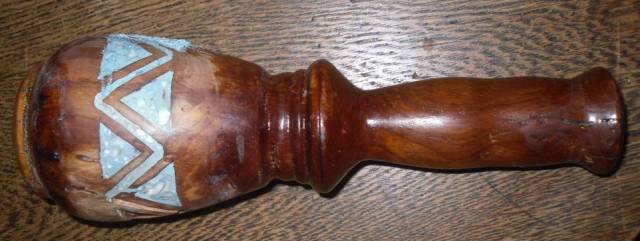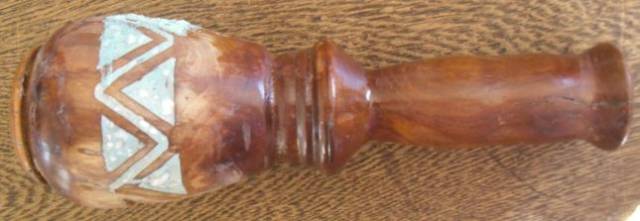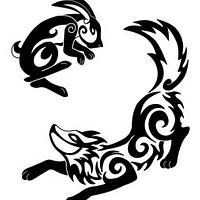Kelly
in almost 12 years
Turquis Inlay - Not
In the course of goofing around with the lathe I picked up a couple months back, I test drove it on some cherry and apple from the prunings of local (thousands of acres) orchards.
Inspired from a visit to the museum just built for the local Wanapum tribe, I copied some of the things I saw being used making long boats, preparing hides and so on.
I made a couple handles and installed them on a heavy planer blade, for use as a scraper. I made a heavy mallet from sycamore, for detail work on dug outs. A couple tribe members bought walking sticks. Now, I’m working on a prototype rattle.
Like the other things, the rattle was fun. When done, it was a bit plain though, so I hand carved a design into it with the idea I’d fill the carving with something.
On a whim, I: 1) bought some colored powders folks use to embellish embossed cards; I crushed up some oyster shells; I mixed some two to one epoxy and added the [turquoise] powder and crushed shell; and, I pushed the mix into the carvings.
Once dried, I could have used the result as a [really ugly] rasp. I sanded until I was back down to wood (the carvings were nearly one eighth inch deep), working my way down, then I took the sanded portion over to the buffer.
In just seconds, the oyster shell was polished to a pearl like finish and the large and small flex might pass for [some strange type of] turquoise.
Because the two to one epoxy flows more than the one to one, I can only do a little at a time, or it flows back out, even with the powder and shell mixed in.
In the end, I like the result enough I might try this on a picture frame, or some other project, by cutting dados into the frame.
Obviously, one can be FAR more precise in laying out and carving wood projects. For example, the dado, mentioned above, would produce a product with precision edges, which would be appropriate for that application. For me, school is still out as to whether I want to spend more time making exact cuts for the rattles, or stay with the “hand carved” appearance (translate – sloppy).
The main point of this is, mixing crushed shells, turquoise colored powder and epoxy makes for an interesting inlay filler.
I’ll add photos in a couple days, after I’ve filled, sanded and polished all the carvings.


4 Comments
I’ve always been interested in stone inlays. I haven’t tried it yet and look forward to seeing what you come up with.
-- Alec (Friends call me Wolf, no idea why)
nice job
jim
very interesting .
Wheaties
This turned out very nice. I collected a few colorful shells when I was in Florida a few weeks ago. I might try this on one of the organic style boxes I have been making recently.
Roger
www.rogergaborski.com
Roger











